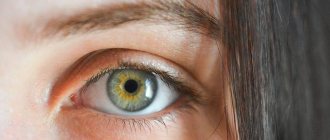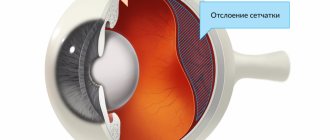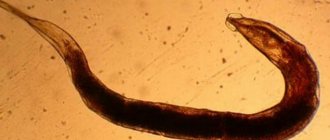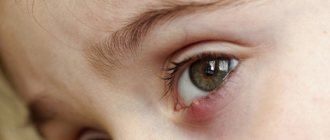An allergy is a disease in which the immune system begins to intensively produce histamine, provoking reactions in the form of skin rashes. Allergies under the eyes arise from irritants that, when they get on the mucous membrane, cause itching, redness and lacrimation.
Only a doctor can identify the cause of the disease and select drug therapy that will help remove negative symptoms and stop the allergic reaction.
Symptoms of eye allergies
Signs of an allergic reaction usually develop within 2–5 minutes after exposure to the irritant. Sometimes they can develop gradually over several hours.
Allergies occur in acute and chronic forms. In the second case, symptoms periodically appear or disappear. The acute form of the disease is accompanied by a rapid onset and has a clear clinical picture.
The clinical picture of an allergic reaction depends on its form. There are allergic rhinitis, dermatitis and conjunctivitis, hay fever and vernal conjunctivitis, allergy to cold.
Giant papillary conjunctivitis
HSC affects those who wear soft contact lenses. Symptoms of the disease include:
- mucus secretion;
- blurred vision;
- sensation of a foreign body in the eye;
- reducing the time of using contact lenses;
- increased sensation on the eye;
- excessive mobility of the CL.
HSC at a late stage is manifested by ptosis, moderate conjunctival injection.
Vernal keratoconjunctivitis
This disease refers to bilateral inflammation of the conjunctiva, which manifests itself in the spring and summer. More often found in the southern regions.
Signs of allergies:
- swelling of the mucous membrane;
- increased sensitivity to light;
- itching in the eyes;
- involuntary contraction of the eyelids, subsequently leading to blepharospasm;
- the appearance of vessels on the periphery;
- papillary hypertrophy.
In severe cases, the disease is manifested by the development of punctate keratitis, clouding and ulceration of the cornea.
Hay conjunctivitis
The disease is caused by pollen from flowering plants. It worsens in spring and summer. The hay fever form of the disease is manifested by a runny nose, attacks of suffocation, sneezing and skin reactions.
Allergic rhinitis
Inflammation of the nasal mucosa is provoked by various irritants. Allergic rhinitis is characterized by swelling, nasal discharge, excessive lacrimation, conjunctival hyperemia and repeated sneezing.
Photo
Parents' actions
If a child has an allergic reaction initially, it is recommended to immediately consult an ophthalmologist or allergist. They will find reasons and factors, tell what parents should do, what treatment to carry out.
If parents already know about their child’s seasonal allergies, it is recommended to adhere to the following rules:
- if possible, travel outside the place where the plant blooms;
- Give your child antihistamines immediately when the first symptoms appear;
- do not open windows while at home, as allergens spread through them;
- Give your child plenty of fluids so that the allergen and immune system cells leave the body faster.
If a child develops a household allergy, it is recommended to immediately remove this substance from the home. For example, if a child is allergic to animal fur, they should not be in the child’s place of permanent residence.
Causes of allergies in the eyes
It develops when harmless substances enter the body and the immune system malfunctions, making the body sensitive to them. Most often, such a failure manifests itself in childhood, but there are cases in adulthood.
The number of people with eye allergies is growing every year. The reasons for this immune system reaction remain unknown. However, doctors name the following factors involved in its development:
- plant pollen;
- indoor dust;
- household chemicals;
- medicines;
- sunlight;
- animal hair;
- infections.
The manifestation of an allergic reaction is influenced by insect bites, the influence of viruses or bacteria, and poor immunity. Only a doctor can determine the exact cause of the disease after conducting a group of diagnostic tests.
Diagnostics
To determine a person’s condition, you need to make an appointment with an allergist. He will conduct a range of diagnostic tests and then prescribe treatment:
- Patient interview. The doctor will listen to all the complaints that concern the person. This may be swelling, redness, inflammation of the eyelids, conjunctiva and other areas of the skin.
- General inspection. If the patient is currently experiencing an allergic reaction, the doctor will detect redness and swelling of the eyes. It is possible for a rash, itching, redness, and peeling to form in any other part of the body.
- General clinical analysis of blood and urine, blood biochemistry.
- Allergy test. It is done in the autumn-winter period, when the patient is not bothered by any disease. Various substances are applied to the wrist. After this, the allergist looks at in which area the inflammatory reaction has formed. Determine the exact substance due to which it was formed.
- Eye swab. He is sent for PCR to detect viruses. They also do bacteriological culture to detect opportunistic and other microflora.
- Analysis of tear fluid to determine the number of immune cells.
- Biomicroscopy. This is an intravital study in which the cellular composition of the surface structures of the eye is determined using a microscope.
- Examination by doctors of narrow specialties. This could be an ophthalmologist, otolaryngologist. They examine the eyes, ears, and nasopharynx. This is necessary to detect or exclude additional diseases.
- Immunogram. This is an extensive study of the cellular composition of the immune system. The doctor discovers which link is overly active or, conversely, suppressed. The data allows us to judge an allergic reaction or immunodeficiency.
Based on these data, the doctor can make a reliable diagnosis. Only after this does therapy begin.
Treatment
Drops
For the treatment of allergic manifestations, antihistamines in the form of drops are mainly used. Medicines neutralize the reactions caused by the irritant.
Drops relieve inflammation and swelling. The whites of the eyes turn white after the first use of the drugs. The itching and burning go away.
The following drops are prescribed:
- Cromoglycate. Apply up to 8 times a day. Can be used by adults and children.
- Allergodil. The medicine blocks histamine receptors and reduces the rate of formation and release of bioactive substances. Apply up to 6 times a day, 1 drop. There should be an equal interval between applications.
- Odoxamide. Use the medication 1-2 drops in each eye up to 4 times a day.
Vasoconstrictor drops are prescribed. They cannot be used for a long time; they cause a withdrawal effect. Vasoconstrictors relieve swelling and reduce redness.
Corticosteroids are prescribed to relieve acute symptoms of the disease. They are prescribed for a short period due to the development of side effects. Corticosteroids include Maxidex and Dexamethasone.
Medicines in tablets
If an allergic reaction develops in the eyes, antihistamines in tablets are prescribed if the patient does not use drops for any reason. The effect of such drugs begins later, but the effect lasts for 24 hours.
Antihistamines:
- Second generation - Loratadine, Ebastine, Cetirizine.
- First generation - Diphenhydramine, Mebhydrolin, Chloropyramine.
Third generation antihistamines are metabolites. They do not cause sedation and are effective. 4th generation drugs are considered the best. These medications have an immediate effect and last a long time.
Medicines have a beneficial effect on the cells responsible for the development of allergies. They are effective for any form of disease, including reaction to a food irritant.
Hormonal and homeopathic medications are prescribed for treatment. For the production of the latter, exclusively natural ingredients are used. Hormonal drugs are prescribed for complex forms of allergic reactions.
After improvement occurs, cromones are prescribed. These are drugs that stabilize mast cells and promote the production of histamine.
Traditional methods
Lotions, rinsing and solutions for internal use will help reduce allergic manifestations.
Effective folk remedies:
- 2 tbsp. l. pour 200 ml of boiled water into the mixture of thyme or chamomile. Infuse the product, strain from the herbs. Use the solution for lotions. Soak cotton pads or gauze in the product and apply to the affected eyes for 10 minutes.
- Mix sage, chamomile and string in equal parts. 1 tbsp. l. pour boiling water over the mixture and leave for 30 minutes. Use for lotions.
- Cold milk helps relieve itching and stinging in the eyes. Use for rinsing and lotions in the morning and before bed.
- Cold cucumber circles are applied to the eyes for 15 minutes. This method helps relieve itching, reduce swelling and burning. Carry out the procedure up to 5 times a day.
- Aloe vera is a panacea for all skin diseases, including eye rashes. Cut the leaf, take the fleshy part and mix with honey in equal quantities. Wash your eyes with this mixture 2 times a day until the symptoms go away.
- Water with rose petal extract relieves inflammation and relieves allergy symptoms. It can be used for rinsing or as eye drops, but after consultation with an ophthalmologist.
- Onions cope perfectly with the problem of red eyes. Peel the onion and cook until tender. The finished broth is mixed with honey, the mucous membrane is washed up to 4 times a day.
- Prepare cornflower infusion by mixing 1 tbsp. l. dried flower with 200 ml of boiling water. Strain the solution and use for dressings.
Causes of allergic inflammation of the eyelids
The most common cause of the condition is the following effects on a person:
- Low-quality cosmetic products, often they may be past their expiration date. In some cases, they contain a substance to which a person becomes hypersensitive.
- Food. This is the most dangerous form, since after swallowing food, a person feels an allergic reaction until the substance leaves the body. In some cases, the reaction on the eyelids is accompanied by severe swelling and attacks of suffocation.
- Insects, parasites, other microorganisms. This category includes bites of midges, bees, and other insects. Also, an allergic reaction can occur due to the penetration of eyelash mites into the eyelid area. Since the parasite is microscopic in size, the patient does not immediately realize its occurrence.
- Sun rays. Allergies do not appear with every exposure to the sun, but only with its intense glow. The condition is detected in the summer, between 10 am and 6 pm, when the most intense solar glow occurs. An allergic reaction appears not only on the skin of the eyelids, but also in any area of the body exposed to ultraviolet radiation.
- Cold. An allergic reaction in a patient is detected at a temperature below 0 degrees. The most commonly affected areas are the hands and the thin skin of the eyelids. This area begins to peel, become inflamed, and itch. In the future, cracking of the skin may occur, leading to the formation of minor bleeding.
- Running water. It may contain various particles to which the patient develops an allergic reaction. The condition is most often caused by the presence of cleaning agents such as bleach. The patient experiences itching and flaking of the skin after each bath.
- Contact lenses. These are the most convenient tools for correcting low vision. But, nevertheless, some people experience increased sensitivity to the use of this product. Swelling, itching, burning, and inflammation of the eyelids are detected.
- Postoperative period of eyeballs and surrounding tissues. The reaction can develop to medications, suture materials, or simply due to tissue damage due to increased activity of the immune system.
- Medications. An allergic reaction is detected after taking a medication. Patients develop not only inflammation of the eyelids, but also other types of allergies, for example, swelling of the tongue, peeling of the skin, and urticaria. Therefore, if there are allergenic substances in the composition, manufacturers always write in the instructions for use about a possible side effect in the form of an increased reaction of the immune system. Allergies to antibiotics, painkillers and other substances often occur.
- Chemicals. When exposed to substances on human skin, a severe burn may occur. It appears due to the formation of volatile compounds, or after direct contact with the drug. Burns often occur in people who work in factories, pharmaceutical and chemical companies. If the substance is volatile, it gradually settles on the skin, accumulating in it. An allergic reaction takes some time to form, but may appear immediately.
- Animals. Pets may have fur, scales, and feathers that contain various allergens. They spread through the air and on household objects, through which they enter the human respiratory tract or directly onto the skin. Sensitization of the body and a local allergic reaction on the eyelids occurs. It is often accompanied by rhinitis.
- House dust. It contains microscopic bugs, which, along with their waste products, spread through the air. Once in the respiratory tract and on skin surfaces, they can cause a local or systemic allergic reaction.
- Flowering plants. Allergies are usually seasonal, starting in late spring and ending in early autumn. There are many different plants to which a person can develop an allergic reaction. For example, poplar fluff, ambrosia. A person develops rhinitis, increased lacrimation, redness of the conjunctiva and eyelids.
These are the main types of substances to which a person can develop an increased reaction of the immune system. But there are many other allergens that can cause redness, inflammation, swelling and itching on the eyelids.
Prevention
You can prevent the development of eye disease by reducing allergens such as pollen, grass, and weeds. To avoid symptoms, regularly ventilate the room, use hypoallergenic pillows and blankets, and wipe off dust daily with a damp cloth.
Other preventive measures:
- taking medications before the start of the flowering season;
- install a window filter;
- limit exposure with pets;
- replace carpets and rugs with wood flooring;
- replace fabric curtains with roller blinds that are easy to wipe clean.
The use of antihistamine drops and anti-inflammatory drugs
Antihistamines block the production of histamine, which accumulates in the human body during allergies. They help fight itching, burning eyes, and relieve inflammation. These drugs are used as the main remedy to combat allergy symptoms. The doctor may prescribe Allergodil, Lekronin, Ketotifen and similar medications.
Allergodil
Lecrolin
Ketotifen
If the baby’s symptoms of the disease are acute, then anti-inflammatory drugs can be used in therapy. These include non-steroidal drugs (NSAIDs) and corticosteroids.
NSAIDs can be used to reduce inflammation in children's eyes, but this can only be done under the direct supervision of a physician. Like the corticosteroids described above, NSAIDs have many side effects. Diclofenac sodium is most often used in the form of a solution containing 0.1% of the medicinal substance.
To combat the effects of allergies, your doctor may recommend using medications that target the mast cells that develop in allergies. When using them, you need to know that the therapeutic effect manifests itself gradually, as the required concentration of the drug accumulates in the baby’s body. Therefore, doctors recommend using such drugs before the allergy season. In this case, the signs of allergies in children are sharply weakened. Usually doctors prescribe Alomide or Kromhexal.
Alomid
Cromohexal
To eliminate redness on or around the retina of the eye when the organ of vision is dry, tear substitutes are used. They can be used several times, as these drugs are absolutely safe. But it is recommended to store them in the refrigerator, this gives the medications an additional calming effect. Usually the doctor prescribes medications for babies such as Natural Tear, Vidisic, Systane, etc.
Natural tear
Vidisik
Systane
If a bacterial infection occurs or the baby develops rhinitis along with an allergy, the doctor may prescribe antibiotics to eliminate the problem. To boost immunity, you may need to take appropriate medications or vitamins.
Methods for diagnosing chronic allergic conjunctivitis
Diagnosis of the allergic form of inflammation of the conjunctiva can only be carried out by an ophthalmologist and an allergist-immunologist. This is especially important if the history clearly shows a connection between inflammation of the conjunctiva and exposure to an allergen. To confirm the diagnosis, specialists carry out:
- Ophthalmological examination: during it, changes in the conjunctiva are revealed (in particular, the presence or absence of edema, hyperemia and other signs). Examination of conjunctival scrapings using a microscope reveals eosinophils and an increase in IgE in the blood, which indicates infection with allergic conjunctivitis.
- Allergological examination: to establish the causes of the onset and development of the disease, a number of tests are taken: elimination (excludes contact with a possible allergen) and exposure (it consists of repeated exposure to the suspected allergen after all symptoms have subsided). When the acute manifestation of symptoms subsides, skin allergy tests are performed. With a temporary retreat of the disease, provocative tests are performed: conjunctival, nasal and sublingual.
- Examination in the laboratory. If allergic conjunctivitis is chronic, the eyelashes are examined for traces of demodex mites.
Typically, the prognosis for treatment of chronic allergic conjunctivitis is favorable. If you do not pay attention to the disease, various infections may occur, which can lead to serious problems, including a decrease in visual acuity. To prevent this, you can use preventative measures. These include no contact with known allergens. If allergic conjunctivitis is seasonal, preventive courses of desensitizing therapy should be used. At the first signs of the development of the disease, you should contact an allergist and ophthalmologist.











